This creature : discourse on women and discourse by women in the Middle Ages
Part of : Γράμμα : περιοδικό θεωρίας και κριτικής ; Vol.1, No.1, 1993, pages 15-39
Issue:
Pages:
15-39
Author:
Abstract:
We have few records of what roles in literary production were open to women in the Middle Ages. Medieval texts written for women, mainly by the clergy, express the official church doctrine that a woman can be saved if she gives up being a woman and becomes a saint, preferably a virgin. This implied leading a “hidden” life, enclosed, silent, and passive. Textswritten for a male or mixed audience, whether clerical or lay, are preoccupied with the female body as a source of sexual corruption. When women themselves write, as within the courtly aristocracy, they tend to follow the conventions of the courtly style, though they show a preference for topics concerned with women’s experience. From the fragmentary evidence we have of an oral popular literary tradition, it seems probable that women there had a recognized role, with genres and topics of their own: man-woman relationships and their implications, especially within the family, erotic love, and the defence of womanhoodin semi-ritual “flytings” with men. Finally, visionary women’s discourse sanctioned a preoccupation with individual experience which, in certain “marginal” cases, developed into early forms of autobiography.
Subject:
Subject (LC):
Notes:
Περιέχει σημειώσεις και βιβλιογραφία




